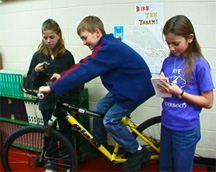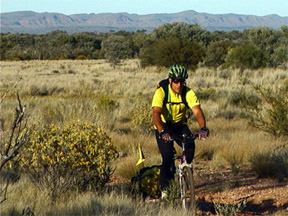
|
|
|
Activities
|
Extensions
|
|
|
|
Background
|
Related
Links
|
Activity
Title: 'Biking the Tanami'
Subject
Area: Physical Education
Grade
Levels: 5th + 6th
|
Students
will investigate their own level of fitness. This is done
through calculating the recovery rate of a person’s cardiovascular
system.
Practical
application of this activity can be a whole class lesson or
incorporated into one of several classroom stations. As a
group activity, students may work ingroups of two-five members.
It is recommended to comprise each group of a range of abilities
and learning levels.
|
 |
Close
monitoring of these groups keeps a balance within the group participation
so that one student is notdominate in completing the work at the
station while others are uninvolved.
Each
member is required to document work completed in their journals
with feedback and calculations. The groups are given twenty minutes
per station to complete their research and work before moving on
to the next station.
Materials:
- stop
watch or watch with second hand
- journals
- pencils
- map
of the Northern Territory, Australia showing the aboriginal community
of Yuendumu and cattle station Moolooloo.
|
Background
and Procedure:
You
are about to set out to ride 330 miles through the infamous
the Tanami Desert from the Aboriginal community of Yuendumu
to the cattle station (ranch) of Moolooloo. The temperature
will be over 100 degree and there is no water other than what
you will carry with you. So it’s a good idea to find
out how fit you are before setting out!
|
 |
The purpose of this lesson is therefore
to measure your own level of fitness. This is done through calculating
the recovery rate of a person’s cardiovascular system.
A traditional way to do this investigation
is measuring the pulse before and after exercise to determine the
time taken for an individual’s heart rate to return to normal.
Pair up with someone and make sure you
have:
- A
stopwatch (1 between 2), and
- Your
journals and pencils.
One
member of each pair measures the pulse of the partner. Holding the
wrist (or any other point of the body they know for checking the
pulse), they count the number of heartbeats per 60-second period.
They can count how many beats in 15 seconds and then multiply it
by 4 to get the total number of heartbeats per minute. Once the
figure is found, it is recorded into their journal. Then the person
whose heart rate was checked pedals on the bicycle for 2 minutes.
No pulse is checked immediately afterwards. Exactly 4 minutes after
the 2 -minute biking session the person’s pulse is checked
again for a 60 second period. The findings are written down. The
partners switch roles and repeat the process.
Analyze
and Conclude:
When
you are all finished you will now interpret the data. You should
have two figures written in you journals, your pulse rate at rest
and pulse rate 4 minutes after the exercise burst.
- Subtract
one from the other to give the 'recovery rate'; this represents
your fitness (the lower the figure, the fitter they are).
- Once
everyone has a figure for their personal fitness, a class average
can be calculated and posted onto the website. A comparison can
be made once other schools post their ‘fitness average’
as well.
Lesson
Extensions:
You
are bicycling the Tanami Track from the Aboriginal community of
Yuendumu to the cattle station (ranch) of Moolooloo. Locate these
two places on the map provided.
The distance is approximately 330 kilometres.
- Convert
the kilometres by multiplying the distance by 0.62.
- How
many miles did you travel?
- What
towns near you are that distance from each other?
- According
to the map, are there services available if you should be in need
of supplies?
- How
does this affect your travel plans?
|
